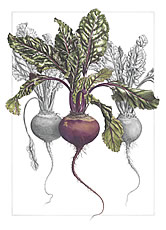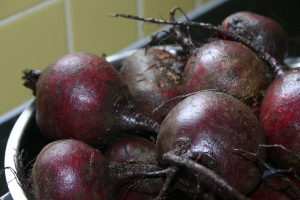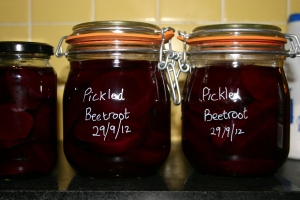Hello there everyone. Here’s just a quick post to prove that I am not dead, but still alive and kicking! I have had such a crazy couple of months getting this business of the ground whilst working at the University of Manchester and Manchester Metropolitan University. Phewee! There’s no rest for the wicked as they say (and if it is true then I must be extremely wicked indeed).
Ann Swan’s beautiful vegetable art
One vegetable that ranks very highly in my favourite foods is the humble beetroot; it would certainly be in my Top 10. Jane Grigson wrote a fantastic book called Good Things in which each chapter focusses on her favourite ingredients. If I were to write my own version, beetroot would be included. It’s that mixture of sweetness and earthiness that you can’t really get from anything else. Some people shudder at the thought of it as a vegetable in its own right – too much overcooked purple mush at school has not done it any favours – and only really eat it as a pickle.
It is actually a very versatile vegetable; you can boil it, roast it, pickle it, and by virtue of its sweetness, use it as a cake ingredient that surpasses the carrot.
Beetroot has been cultivated for centuries and its ancestor is the sea beet Beta marinama a rather common plant found around the coasts of Eurasia, especially along the Mediterranean Sea. It is from this plant we get today’s red beet (plus several other varieties like the golden beetroot) as well as sugar beet and the less well-known mangel-wurzel or mangold. The latter is used mostly as animal fodder, though it has been a food crop for people too in the past (for those of you that remember it, the scarecrow Wurzel Gummidge had a head made from mangel-wurzel). The history of sugar beet is very interesting and deserves a post all to its own. Oddly enough, the beet plant wasn’t cultivated for its sweet tap roots at first, but its leafy greens. Indeed, our Swiss chard is also of the same species as beetroot and sugar beet. Eating the root didn’t catch on until the 16th century.
There is loads of beetroot hanging around at the moment and it should be reasonably cheap in the greengrocer’s shop this time of year, so you should jump at the chance to having a go at preserving them. I got a huge batch from Manchester Veg People.
I have already provided a recipe for curried beetroot chutney, but I thought I’d give you the recipe I use to pickle beetroot as well. I first came across it in Good Things (1932) by Florence White, who mentions that the recipe must be very old, though she mentions neither when it was written or by whom. I did find an almost identical recipe as I was flicking through a copy of Mrs Beeton’s Book of Household Management (1861; which can be read online; see this link here).
It is the inclusion of an infusion of black peppercorns and allspice that really makes this pickle special. You’ll never go back to buying jars of it ever again! It’s important to remember to not peel the beetroots before you cook them, otherwise their wonderful colour will be lost to the cooking water.
Pickled Beetroot
2 kg (4 ½ lbs) beetroot
1 ¼ litres (2 pints) cider vinegar
15 g (½ oz) peppercorns
15 g (½ oz) allspice berries
Top and tail but do not peel the beetroot, then simmer them in plain water for around 30 minutes until tender. Very large ones may take over an hour to cook. Meanwhile, boil up the vinegar with the spices and simmer for 10 minutes then strain. Let the beetroots and vinegar cool completely before peeling and slicing the beetroots.
Put into sterilised jars and cover with the strained, cooled vinegar. In two weeks they’ll be ready to enjoy.
If you like the blogs and podcast I produce, please consider treating me to a virtual coffee or pint, or even a £3 monthly subscription: follow this link for more information.





Nigel Slater last night, you today – it is obviously time to cook some beetroot. And I picked up a load at the farmers market yesterday. We are out of beetroot and orange chutney so I’d better make more of that – especially as several friends expect it for Christmas, and I’d forgotten chocolate beetroot cake until Slater made it on the telly. So I’ll do that again to reward myself after the day’s jobs are done.
LikeLike
I’m glad Slater has done a spot on them; I’ve had this post half-written for ages. I thought I should finish it – and like buses 2 have come along at once for you. What did he make other than the cake?
I have been making beetroot butterfly buns recently and they have gone down very well. I’m thinking of doing a series!
LikeLike
Thanks for the great post about beets (as we call them here in the US! I love them too (especially my mother’s pickled beets), but often hesitate before serving them to guests because so many people have such an irrational prejudice against them. Several months ago, I wrote a post about how I came to conquer my own prejudice: http://academyoffood.blogspot.com/2012/09/apples-honey-and-beets.html
LikeLike
I have done the same with salmon, though I haven’t managed to get round to whisk(e)y as yet. Maybe a need to do a series of posts on foods that have – quite wrongly – been given a bad name
The Moroccan salad looks delish!
LikeLike
Looks delicious. So there is enough acid in the vinegar that you don’t have to do a canning waterbath? This is one of my favorite foods. I figure also all that red must be good for you. With chard I make capuns, which I blogged about under GoodbyeHouston, ancient for the Romansch of Switzerland, not here. Looks like Susanne is joining our group!
LikeLike
Hello there! I always cool my vegetables or eggs and the pickling liquor before bottling. I do make sure that the vinegar is at least 5% acid though.
We don’t eat much chard in the UK, though it is a gardeners’ favourite.
Glad Susanne is joining – she’ll be a great addition!
LikeLike
Pingback: Pickling at Home | British Food: A History